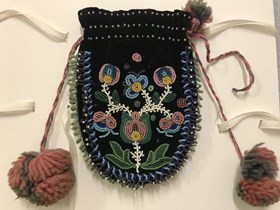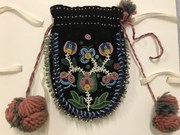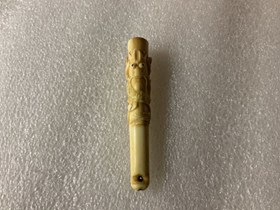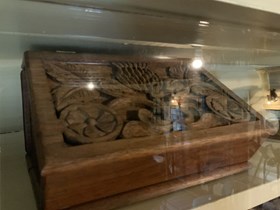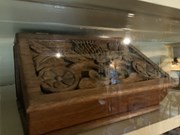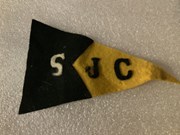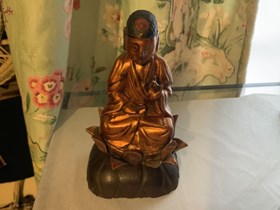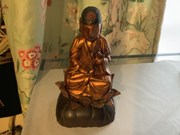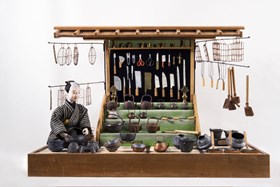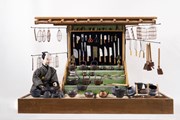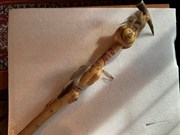Narrow Results By
- Peter Whyte (1905 – 1966, Canadian) 6
- Anne Rebeyka 3
- Catharine Robb Whyte, O. C. (1906 – 1979, Canadian) 3
- Hiroshi Yoshida (1876 – 1950, Japanese) 3
- Unknown 3
- Al Mettel 1
- Alice Saltiel (1948 – , Canadian) 1
- Beatien Yazz 1
- Bernbaum, Edwin 1
- Dale Auger (1958 – 2008, Canadian) 1
- George Weber (1907 – 2002, Canadian) 1
- Henry George Glyde (1906 – 1998, Canadian) 1
- Date
- 1890 – 1910
- Material
- hair, sheep; glass; fibre
- Catalogue Number
- 103.08.0012
- Description
- A black velvet pouch with a looped bead fringe along the edges. The bag has a twisted, faded red wool cord at the neck with wool pom-poms at each end. The bag is decoarated with multicoloured beadwork on the front with a tulip-like flower with other flowers on a vine extending from the tulip-like…
1 image
- Title
- Beaded Bag
- Date
- 1890 – 1910
- Material
- hair, sheep; glass; fibre
- Dimensions
- 11.0 x 16.0 cm
- Description
- A black velvet pouch with a looped bead fringe along the edges. The bag has a twisted, faded red wool cord at the neck with wool pom-poms at each end. The bag is decoarated with multicoloured beadwork on the front with a tulip-like flower with other flowers on a vine extending from the tulip-like flower.
- Credit
- Gift of Pearl Evelyn Moore, Banff, 1979
- Catalogue Number
- 103.08.0012
Images
This material is presented as originally created; it may contain outdated cultural descriptions and
potentially offensive content.
Read more.
Cigarette Holder
https://archives.whyte.org/en/permalink/artifact103.08.0179
- Date
- 1900 – 1935
- Material
- ivory
- Catalogue Number
- 103.08.0179
- Description
- A carved ivory cigarette holder featuring the figure of a demon with a monkey-like face. The demon’s eyes have painted black pupils. The holder has a hole at the top of the stem, rather than through the centre at the end, to allow smoke to pass into the mouth.
1 image
- Title
- Cigarette Holder
- Date
- 1900 – 1935
- Material
- ivory
- Dimensions
- 1.3 x 1.3 x 7.6 cm
- Description
- A carved ivory cigarette holder featuring the figure of a demon with a monkey-like face. The demon’s eyes have painted black pupils. The holder has a hole at the top of the stem, rather than through the centre at the end, to allow smoke to pass into the mouth.
- Subject
- smoking
- ceremonial
- religious
- Credit
- Gift of Pearl Evelyn Moore, Banff, 1979
- Catalogue Number
- 103.08.0179
Images
This material is presented as originally created; it may contain outdated cultural descriptions and
potentially offensive content.
Read more.
- Date
- 1955 – 1965
- Material
- mineral, onyx; fibre
- Catalogue Number
- 103.09.0018 a,b
- Description
- A smoothly polished flat onyx stone (a) in a red velour carrying case (b) lined with satin. The stone has a finger depression carved into one side. Inside of the box the satin is marked with “Calmulet” in gold writing. The stone is also accompanied by a small pamphlet, which fits inside the box,…
1 image
- Title
- Amulet
- Date
- 1955 – 1965
- Material
- mineral, onyx; fibre
- Dimensions
- 0.8 (a); 3.0 (b) x 3.5 (a); 7.0 (b) x 5.8 (a); 8.5 (b) cm
- Description
- A smoothly polished flat onyx stone (a) in a red velour carrying case (b) lined with satin. The stone has a finger depression carved into one side. Inside of the box the satin is marked with “Calmulet” in gold writing. The stone is also accompanied by a small pamphlet, which fits inside the box, and explains how the stone is used. The pamphlet reads:“As the ancient Chinese pondered the weighty problems of their time, or contemplated deep philosphies, it was their practice to stroke the smooth polished surface of valuable jade, a habit they found soothing to tired minds and tense nerves.The Egyptians and Greeks of long ago wore amulets, usually suspended from the neck, as a protection from the evil eye. It was a recognized good luck charm. Even the very religious Moslums believed in the power of the amulet.Now the amulet is once more being sought as a potential calmer of jangled nerves. The CALMULET is designed for this purpose. Hold it in the palm of your hand . . . it is especially shaped to nestle there, inviting nervous fingers to gently rub it’s smooth satiny surface.CALMULET a finely cut lustrous onyx will become your personal talisman.”
- Subject
- medicinal
- religious
- superstitions
- Credit
- Gift of Pearl Evelyn Moore, Banff, 1979
- Catalogue Number
- 103.09.0018 a,b
Images
This material is presented as originally created; it may contain outdated cultural descriptions and
potentially offensive content.
Read more.
- Date
- 1800 – 1875
- Material
- wood
- Catalogue Number
- 109.02.0016
- Description
- A wooden box with a sloped front side which hinges at the top to open. The front is carved with a single large thistle and leaves with a circular blossom in each of the lower corners. There is a long slot cut into the top of the box.
1 image
- Title
- Tithe Box
- Date
- 1800 – 1875
- Material
- wood
- Dimensions
- 14.0 x 23.0 cm
- Description
- A wooden box with a sloped front side which hinges at the top to open. The front is carved with a single large thistle and leaves with a circular blossom in each of the lower corners. There is a long slot cut into the top of the box.
- Credit
- Gift of Pearl Evelyn Moore, Banff, 1979
- Catalogue Number
- 109.02.0016
Images
This material is presented as originally created; it may contain outdated cultural descriptions and
potentially offensive content.
Read more.
- Date
- 1895 – 1908
- Material
- fibre
- Catalogue Number
- 105.02.0058
- Description
- A small triangular pennant made from a swallow-tailed piece of black felt stitched to a pointed piece of gold felt with the letter 'S' in white on the black portion, and the letters 'J' and 'C' in black on the gold.
1 image
- Title
- Pennant
- Date
- 1895 – 1908
- Material
- fibre
- Dimensions
- 8.5 x 14.5 cm
- Description
- A small triangular pennant made from a swallow-tailed piece of black felt stitched to a pointed piece of gold felt with the letter 'S' in white on the black portion, and the letters 'J' and 'C' in black on the gold.
- Credit
- Gift of Pearl Evelyn Moore, Banff, 1979
- Catalogue Number
- 105.02.0058
Images
This material is presented as originally created; it may contain outdated cultural descriptions and
potentially offensive content.
Read more.
- Date
- 1930 – 1940
- Material
- wood
- Catalogue Number
- 107.01.0086
- Description
- A seated buddha with his feet in a lotus position at the centre of a lotus blossom. His right hand rests palm up in his lap and the left is raised in a blessing (or teaching position). The carved figurine is wood with simple features, large ears, and draped robes. The figurine is painted a saffro…
1 image
- Title
- Figurine
- Date
- 1930 – 1940
- Material
- wood
- Dimensions
- 12.7 x 6.0 x 7.0 cm
- Description
- A seated buddha with his feet in a lotus position at the centre of a lotus blossom. His right hand rests palm up in his lap and the left is raised in a blessing (or teaching position). The carved figurine is wood with simple features, large ears, and draped robes. The figurine is painted a saffron gold colour with red and black features and black hair with carved and red painted dot at front centre of hair. The figurine is loosely attached to a simply carved brown wood base of leaves curling downward with dowel through base of the buddha. There are Chinese letters on the base of the stand and “1.50” along with a paper sticker that reads “China:.
- Subject
- households
- souvenirs
- religious
- Buddah
- Credit
- Gift of Pearl Evelyn Moore, Banff, 1979
- Catalogue Number
- 107.01.0086
Images
This material is presented as originally created; it may contain outdated cultural descriptions and
potentially offensive content.
Read more.
Miniature, Ironmonger Shop
https://archives.whyte.org/en/permalink/artifact105.02.0114
- Date
- 1870 – 1890
- Material
- wood; fibre; paper; ceramic; metal
- Catalogue Number
- 105.02.0114
- Description
- Japanese ironmonger shop, fully furnished. Wooden base 3.2 high forms floor, display area centre of floor, 19.0 x 16.5 x 10.6. 3 horizontal poles attached to both sides of the display shelf. Display area has green covered steps, black wall with items hung on it, small wooden shelf for more display…
1 image
- Title
- Miniature, Ironmonger Shop
- Date
- 1870 – 1890
- Material
- wood; fibre; paper; ceramic; metal
- Dimensions
- 23.0 x 21.3 x 33.2 cm
- Description
- Japanese ironmonger shop, fully furnished. Wooden base 3.2 high forms floor, display area centre of floor, 19.0 x 16.5 x 10.6. 3 horizontal poles attached to both sides of the display shelf. Display area has green covered steps, black wall with items hung on it, small wooden shelf for more display. Shopkeeper, man dressed in brown grey kimono, brown apron, yellow fabric stuffed in front, is kneeling on the floor. Head is partly shaved with along top knot. Fine china face and hands, hands on lap. Items for sale: various kinds of cooking knives, scissors, teapots, cauldrons, rice cookers, basins, hoes, scythes, altar pieces for buddhism and shintoism worship, cooking stoves, fish broiling metal wire grills, shovels.
- Subject
- households
- miniatures
- business
- figure
- male
- religious
- Japanese
- Edward S. Morse
- Edith Morse Robb
- Credit
- Gift of Catharine Robb Whyte, O. C., Banff, 1979
- Catalogue Number
- 105.02.0114
Images
This material is presented as originally created; it may contain outdated cultural descriptions and
potentially offensive content.
Read more.
Miniature; Japanese House
https://archives.whyte.org/en/permalink/artifact105.02.0120
- Date
- 1870 – 1890
- Material
- wood; paper
- Catalogue Number
- 105.02.0120
- Description
- Traditional Japanese house model. 2 storey wood construction which disassembles into 10 pieces. The rectangular base is raised slightly above ground level by a narrower under base. 12 wood and paper, and 2 wooden lattice work sliding panels open up to verandas on each level, front and back. 1 hinge…
1 image
- Title
- Miniature; Japanese House
- Date
- 1870 – 1890
- Material
- wood; paper
- Dimensions
- 21.8 x 19.7 x 27.3 cm
- Description
- Traditional Japanese house model. 2 storey wood construction which disassembles into 10 pieces. The rectangular base is raised slightly above ground level by a narrower under base. 12 wood and paper, and 2 wooden lattice work sliding panels open up to verandas on each level, front and back. 1 hinged door of wood and paper in front, roof is peaked with exterior ride pole and no decoration. The 2 sides of the roof are held together by a piece of tape which acts like a hinge. Inside a raised platform spans the width and 3/4 the length of the main floor. The second floor is made from a single thin slab of wood. "Made in Japan" is stamped onto tape on roof, both bases, the second floor, the front and back walls and the free standing partition. Upper middle class house for family of 4 or 8. Upstairs, sleeping quarters, 6 or 4 separate rooms divided by sliding, removable) doors, 2 rooms used for sleeping , 2 or 3 per room. 1 room reserved for special living room ? with "Tokono-Ma". where hanging scroll hangs, and where flower arrangement is weekly changed. 1 room used for Buddhism altar. 6 feet high, 2 1/2 feet wide. with ancestors after death names, etc. Altar flower is changed every week. Steamed rise is presented every morning. Any special gift, especially food, cakes, cookis, etc. is placed in front of this altar before anyone unwraps it. Those 2 rods are used for overnight company with the best hudon and so forth. All the rooms could be turned into one large banquet room. Downstairs, 2 rooms , on the floor, and kitchen on the dirt floor? 1 room , living room and eating room, during the day, sleeping room for a couple during the night? 1 room, further from the main road and the better room during the day, sleeping room during the night?
- Credit
- Gift of Catharine Robb Whyte, O. C., Banff, 1979
- Catalogue Number
- 105.02.0120
Images
This material is presented as originally created; it may contain outdated cultural descriptions and
potentially offensive content.
Read more.
- Date
- 1965 – 1975
- Material
- wood; hair; feathers; antler
- Catalogue Number
- 104.06.0014
- Description
- A rod carved from burled piece of wood with a band of light brown fur at top and an antler prong set crosswise in a notch across the top tied securely with sinew. Antler piece painted with a black and a red band at the end. Large globular burl at top has features of two circular faces charred into …
1 image
- Title
- Club
- Date
- 1965 – 1975
- Material
- wood; hair; feathers; antler
- Dimensions
- 7.5 x 14.5 x 60.6 cm
- Description
- A rod carved from burled piece of wood with a band of light brown fur at top and an antler prong set crosswise in a notch across the top tied securely with sinew. Antler piece painted with a black and a red band at the end. Large globular burl at top has features of two circular faces charred into wood and another face profile of person painted red. Burl on one side in the middle has carved profile of horse's head painted red with features accented by charring. Two smaller burls near bottom are carved into animal face painted red and mouse painted yellow, with features accented by charring. Four black and red bands are around stick below top burl and another band of charred dots is around stick below middle burl. Group of three feathers tied just above middle burl with sinew.
- Subject
- Indigenous
- lore
- religious
- souvenir
- Credit
- Gift of Catharine Robb Whyte, O. C., Banff, 1979
- Catalogue Number
- 104.06.0014
Images
This material is presented as originally created; it may contain outdated cultural descriptions and
potentially offensive content.
Read more.
- Date
- 1880 – 1900
- Material
- metal; wood
- Catalogue Number
- 105.03.0017
- Description
- Hand bell with wooden handle and brass collar and bell. Brass clapper suspended on iron hook. Collar at base of wooden handle was riveted but has loosened. Clapper marks inside bell rim.
1 image
- Title
- Church Bell
- Date
- 1880 – 1900
- Material
- metal; wood
- Dimensions
- 21.5 cm
- Description
- Hand bell with wooden handle and brass collar and bell. Brass clapper suspended on iron hook. Collar at base of wooden handle was riveted but has loosened. Clapper marks inside bell rim.
- Credit
- Gift of Catharine Robb Whyte, O. C., Banff, 1979
- Catalogue Number
- 105.03.0017
Images
This material is presented as originally created; it may contain outdated cultural descriptions and
potentially offensive content.
Read more.

